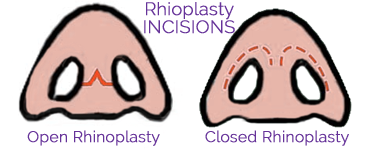Specialized African American Rhinoplasty (Nose Jobs)
The Art of Rhinoplasty (Nose Jobs) for African Americans –
Just as people from different ethnic backgrounds typically have different hair texture, eye color or skin tone – people of different ethnicities also generally have different nasal shapes. Usually, though not always, men and women of African American descent have a shorter nose and/or a wider base of the nose, with so-called “flared” nostrils.
Ideals of beauty vary from culture to culture, from country to country to country, and even from decade to decade. It takes a talented rhinoplasty surgeon like Dr. Ali to understand how to enhance a patient’s natural beauty by restructuring the nose to complement the rest of the face, without erasing the ethnic heritage that makes you who you are.
In other words, it is important for African Americans to seek out a plastic surgeon who does not just “generalize” African rhinoplasty and give everyone a “Caucasian” nose.
An African American rhinoplasty specialist, like Detroit area board certified plastic surgeon Dr. Ali, will take a more personalized approach to rhinoplasty. For men and women of color, Dr. Ali will customize each patient’s nose job surgery to enhance their appearance without erasing “who they are.”
Considerations of African American Nose Jobs
Some of the distinct characteristics of African American noses are visible from the outside. However, there are also other differences that only the plastic surgeon sees within the nasal structure itself, below the surface. Because the anatomy of the nasal framework and nasal bones of African American patients can differ from other ethnicities, it is essential that the plastic surgeon understand these differences.
The cartilage in the “tip” of African Americans noses tends to be less prominent than in Caucasians or Asians. This smaller projection can result in a nose that is wider and nostrils that are “flared”. Surgeons using outdated techniques will sometimes implant a silicone or Gortex tips in Black patients who wish greater nasal ‘projection’. However, this is ill-advised. Synthetic implants often migrate and move over the years – and can even eventually poke through the skin. Most patients with implants will need to have them removed and/or revised at some point over time.
Instead of implants, Dr. Ali uses autologous grafts – which are cells taken from the patient’s own body to build the nasal bridge. These cells the become incorporated into the patient’s nose, and therefore do not migrate – providing lifelong results.
Another consideration of Black nose jobs is care not to remove too much tissue in an attempt to make a nose smaller. Removing large amounts of nasal cartilage weakens the skeletal support, often resulting in deformity or complete collapse over time. An example of too much cartilage removal is Michael Jackson’s nose job – which left him with almost no nose at all!
Rather than removing cartilage, a skilled surgeon will preserve skeletal support by reshaping, repositioning, or reinforcing the tip cartilage, not removing it.
Nose Job Surgery and Black Skin
Additionally, the nasal skin of African American populations is often thicker as well as more prone to scarring than the skin of other ethnicities. Dark-skinned people develop thick ‘keloid’ scars 15 times more frequently than lighter-skinned individuals. A skilled plastic surgeon will understand this – and take the steps to to ensure that there is no visible scarring.
Also, because the nasal bones of some black men and women have a more horizontal than vertical orientation, simply fracturing the nasal bones often will not allow them to be narrowed sufficiently. In these cases, the autologous tissue grafts discussed above are better for increasing the definition of the bridge of the nose. This process can build up a low nasal bridge and wider tip, to improve facial balance and proportion, without giving Black patients a nose that looks “out of place.”
See Your Nose Job Before Your Surgery with 3d Imaging
AMAE Plastic Surgery is among the first and only plastic surgery practices in the Detroit area to offer state-of-the-art Vectra 3D imaging. This revolutionary computerized imaging system provides a three-dimensional digital image of the patient’s nose from any and every angle – so that Dr. Ali can show you your nose shape options and expected outcomes before your rhinoplasty surgery!
With Vectra M2 3D patients can compare “before and after” nose job views side-by-side, so that they can see an approximation of the new nose shape and size that rhinoplasty surgery can deliver.
African American Nose Jobs (Rhinoplasty) Surgeon
Dr. Ali understands that one-size-fits-all never applies to beautiful noses. He will customize a rhinoplasty for you that offers the aesthetic alterations you desire, without erasing your important ethnic background.
Before performing an African American rhinoplasty procedure, Dr. Ali will carefully examine your nasal structure and consult with you on the best course of action to ensure a naturally beautiful result – ensuring optimal harmony between the nose and the rest of your face, while preserving the natural beauty of your proud African American heritage.



